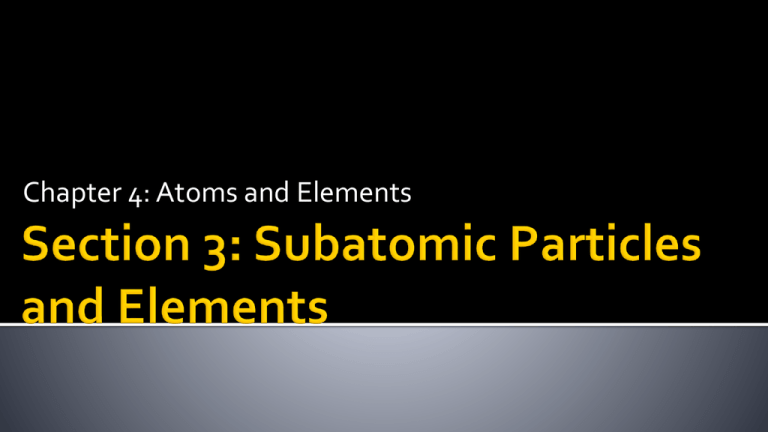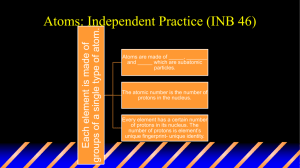Chapter 4: Atoms and Elements
advertisement

Chapter 4: Atoms and Elements Describe the respective properties and charges of electrons, neutrons, and protons. Determine the atomic symbol and atomic number for an element using the periodic table. Proton: a positively charged subatomic particle (p) Located in the nucleus 1 proton has a charge of +1 Actual Mass = 1.67262 x 10-27 kg Relative Mass = 1.0073 atomic mass units (amu) Elements are defined by their numbers of protons. If an atom had a different number of protons, it would be a different element. The number of protons in the nucleus of an atom is its atomic number and is given the symbol Z. Hydrogen always has 1 proton Carbon always has 6 protons How many protons are in: Argon? Plutonium? Electron: a negatively charged subatomic particle (e-) Located in the space surrounding the nucleus 1 electron has a charge of -1 Actual Mass = 0.00091 x 10-27 kg Relative Mass = 0.00055 amu ▪ About 1/1840 of the mass of a proton (small enough to be negligible) In a neutral atom, the number of electrons is equal to the number of protons. Hydrogen has 1 electron Carbon has 6 electrons How many electrons are in? Argon? Plutonium? Neutron: a subatomic particle that has no charge (n) Located in the nucleus Actual Mass = 1.67493 x 10-27 kg Relative Mass = 1.0087 atomic mass units (amu) The number of neutrons in an atom can vary. Electrical charge is a fundamental property of protons and electrons. Positive and negative electrical charges attract each other. Positive–positive and negative–negative charges repel each other. Positive and negative charges cancel each other so that a proton and an electron, when paired, are charge-neutral. Matter normally has a neutral charge equal numbers of positive and negative charges that cancel out In an electrical storm, the charge balance of matter is disturbed. The quick rebalancing of charge often occurs in dramatic ways, such as is seen in lightning. It is the number of protons in the nucleus of an atom that identifies the atom as a particular element. The periodic table of the elements lists all known elements according to their atomic numbers. Most chemical symbols are based on the English name of the element. Hydrogen (H), Carbon (C), Oxygen (O) Some symbols are based on Latin names. Potassium (K) – from the Latin kalium Sodium (Na) – from the Latin natrium Additional elements with symbols based on their Greek or Latin names include the following: lead (Pb), mercury (Hg), iron (Fe), silver (Ag), tin (S), copper (Cu) Early scientists gave newly discovered elements names that reflected their properties: Argon, from the Greek argos, means “inactive.” Other elements were named after countries: Polonium after Poland; Francium after France Other elements were named after scientists. Curium is named after Marie Curie, a chemist who helped discover radioactivity and also discovered two new elements. Curie won two Nobel Prizes for her work. List the atomic symbol and atomic number for each element. Silicon Potassium Gold Antimony


